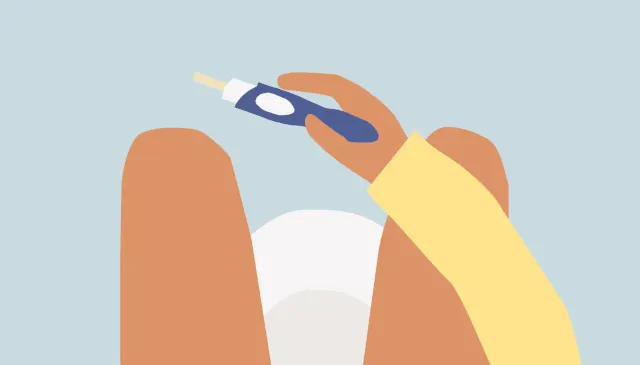Here's what we'll cover
Here's what we'll cover
The vaginal ring is a safe method of birth control that can protect you from unplanned pregnancy (if used correctly). If you’re wondering how this form of contraception works or if it’s the right one for you, get ready — we're about to give you all the information you're looking for.
Keep reading to find out:
How does the vaginal ring work? The science behind the ring
The vaginal birth control ring is exactly that — a flexible plastic ring placed inside the vagina that releases hormonal birth control. There are two types of rings: NuvaRing and Annovera. While both contain hormonal birth control, the exact hormones used vary depending on which kind you're using. Both NuvaRing and Annovera are combined hormonal contraception, and that means they each contain more than one kind of hormone. NuvaRing contains etonogestrel (progestin) and ethinyl estradiol (an estrogen). Annovera contains segesterone acetate, a newer progestin (it was introduced into medical use in the year 2000), and ethinyl estradiol.Both NuvaRing and Annovera prevent pregnancy by:
Suppressing ovulation (no release of an egg means there's nothing for sperm to fertilize)
Thickening cervical mucus to keep sperm from reaching an egg
Thinning the lining of the uterus (also preventing sperm from catching up to that egg)
The ring is prescribed by your healthcare provider, and you remove and insert it on a schedule, depending on which kind you have.
What’s the difference between the brands?
NuvaRing has been available for use in the US since 2002. In order to use it to prevent pregnancy, you insert it for 21 days and then remove it for seven. During those seven days, you'll experience bleeding — but that’s not your period (more on this below). Before you insert a new ring, make sure you read the instructions on the package so you know when to refrigerate NuvaRing. (It might sound weird, but it’s true: You’ll need to make room in your fridge for this form of contraception.)
In 2018, Annovera was approved for use by the FDA. You can use one Annovera ring for a whole year, inserting it for 21 days and then removing it for seven days, but you use the same ring for 13 cycles (as opposed to NuvaRing, which gets replaced every 21 days). Annovera comes with its own case for storage, but it doesn’t need to be refrigerated. (Bonus points for those of us with a fully stocked fridge!)
According to Dr. Eva Luo, an OB-GYN at Beth Israel Deaconess Medical Center in Boston, "Good candidates for the Annovera are likely those who were fans of the NuvaRing, but found the cycle-to-cycle management of making sure a new NuvaRing was obtainable per month too cumbersome."If the bleeding isn’t your period, then what is it?What’s actually happening when you remove the vaginal ring is withdrawal bleeding. A withdrawal bleed refers to bleeding in the setting of hormone use, particularly when hormones are stopped," says Dr. Luo. For example, for patients taking birth control pills, the last week is often a placebo week, and with the "withdrawal" of hormones in that last week, bleeding begins. This withdrawal bleed is not actually a true period because ovulation does not occur when taking birth control pills; but this bleeding simulates the timing of menstrual bleeding.” (This is different from breakthrough bleeding, which is unanticipated bleeding.)Withdrawal bleeding usually begins two to three days after removing the ring and you may still be bleeding when you insert the new one. You can avoid that bleeding, and use the ring as continuous birth control, by putting a new ring in every 21 days instead of taking that seven-day break.
The pros, the cons, and the good-to-knows
Okay, now you know the different types of vaginal rings. To determine if the vaginal ring is the right choice of birth control for you, let’s walk through everything from pros and cons to costs and insurance.
What's so great about the vaginal ring?
The ring is used by around 1.5 million uterus owners worldwide, and between 2004 and 2014, there were 44 million prescriptions written for it in the US alone.
Why? The ring is super solid birth control if you use it perfectly — but since humans aren't perfect, we're talking about a 91% effectiveness rate. You can ensure the ring is the most effective by replacing it when you're supposed to and making sure it's in your body when it needs to be.
In addition to being great at preventing pregnancy, the ring is accompanied by some other big-time benefits:
One size fits every vagina, so there's no need for a personalized fitting.
You don't need to remember to take a pill every day.
You don't have to interrupt sex to put it in.
You can take it out during sex and leave it out for up to three hours while still being protected (but you don’t have to take it out at all!).
It's safe for folks with latex allergies.
It's less likely to cause irregular bleeding than oral combination hormone birth control pills.
Because smaller levels of hormones are used in the ring than in other types of hormonal birth control (like the pill), there's a reduced risk of side effects.
According to Planned Parenthood, the ring can also prevent or lessen:
Breast and ovarian cysts
Acne
Bone loss
Endometrial and ovarian cancers
Iron deficiency
PMS
What are the side effects and risks of vaginal rings?
Hormonal contraceptives come with side effects and, depending on your age, physical health, and medical history, certain types might be more or less appropriate for you. Your healthcare provider will discuss the side effects of the ring with you, but if you’re eager for some of that info ahead of time, we’ve got you covered.
NuvaRing's
Headaches or abdominal pain
Nausea or diarrhea
Breast tenderness
Increased vaginal discharge
Vaginal irritation or infection
Breakthrough bleeding or spotting
Mood changes
Diminished sex drive
Increased risk of blood-clotting problems, heart attack, and stroke
Increased risk of liver cancer, gallbladder disease, and toxic shock syndrome (TSS)
Annovera's
Abnormal bleeding
Headaches/migraines
Vaginal discharge/infections
Nausea/vomiting
Fungal infections
Lower/upper abdominal pain
Menstrual cramps
Urinary tract infections (UTIs)
Breast tenderness/pain/discomfort
Diarrhea
Genital itching
For both the NuvaRing and Annovera, smoking increases risk of cardiovascular side effects, including blood clots, heart attack, and stroke. Being over age 35 and the number of cigarettes smoked by a person further increases these risks, which is why healthcare providers advise that cigarette smokers over 35 shouldn't use either type of vaginal ring.
You should seek medical attention right away if you experience
Sudden back or jaw pain along with nausea, sweating, or trouble breathing
Chest pain or discomfort
Achy soreness in your leg
Severe pain in your belly or stomach
Headaches that are different, worse, or happen more often than usual
Flashing, zigzag lines in your vision (aura)
Yellowing of the skin or eyes
How can the vaginal ring impact fertility?
What happens if you decide you're ready to start trying to conceive? Dr. Luo says that, similar to the pill, "Some patients resume their normal cycles immediately. But I'd say, on average, it will take about three months for normal periods to resume."
Keep in mind that if you started taking hormonal birth control to relieve symptoms that come with conditions like polycystic ovary syndrome (PCOS), those symptoms will return when you stop taking birth control. Says Luo: "If you had irregular periods prior to the ring, depending on the reason for your irregular periods, your 'normal cycles' will likely be irregular again after the ring."
How much does the vaginal ring cost (and will insurance cover it)?
Without insurance, an Annovera ring is around $2,098 (that's one ring for one year). NuvaRing can cost up to $200 without insurance, and you need a new ring every month. If you don't have insurance, Planned Parenthood offers programs to make the ring (and other birth control options) affordable. With insurance, however, the ring may be low cost or even free. Check with your insurance provider to find out what they cover.
You need a prescription for the ring, so remember to factor in the cost of a doctor's visit along with the actual ring.
Who shouldn't get vaginal rings?
Your healthcare provider may recommend that you not use the NuvaRing or Annovera if you:
Smoke and are over 35 years old (like we mentioned earlier, smoking increases the risk of more severe side effects)
Have or have had blood clots in your arms, legs, eyes, or lungs
Have an inherited problem with your blood that makes it clot more than normal
Have had a stroke or heart attack
Have certain heart valve problems or heart rhythm problems that can cause blood clots to form in the heart
Have high blood pressure that medicine can't control
Have diabetes with kidney, eye, nerve, or blood vessel damage
Have unexplained vaginal bleeding
Are pregnant or think you might be pregnant
Have or have had breast cancer or any cancer that is sensitive to estrogen
Have cerebrovascular disease (reduced blood flow to your brain) or coronary artery disease (reduced blood flow or blockage in one or more of the arteries that supply blood to your heart)
Have headaches or migraines that cause changes in vision (including auras), numbness or weakness, or are over age 35 years old and have any type of migraine headaches
Have liver disease or a liver tumor
Take any Hepatitis C drug combination containing ombitasvir, paritaprevir, or ritonavir, with or without dasabuvir
Are allergic to any of the ingredients in NuvaRing or Annovera
And if you take any of the following, NuvaRing may not work as well:
The antibiotics rifampin, rifampicin, and rifamate (other antibiotics don't make the ring less effective)
The antifungal Griseofulvin (other antifungals don't make the ring less effective)
Certain HIV medicines
Certain anti-seizure medicines (these are sometimes also used to treat psychiatric disorders, like bipolar disorder)
The herb St. John's wort
If you're using any of these while also on the ring, use a backup method of birth control.
What's it like to get and have a vaginal ring?
There are lots of good reasons to get acquainted with your body, but here's another one: it will make inserting the ring a lot easier. As we mentioned up top, the ring is super effective birth control, but Dr. Luo says she doesn't see many requests for it in her practice. She speculates that this is "likely due to personal discomfort with placing and removing something in the vagina." If you already use tampons or a menstrual cup, inserting the ring might not be so psychologically scary.
Here's how to get that vaginal ring in place:
Wash your hands with soap and water.
Get in a comfortable position (like standing with one leg up, squatting, or lying down).
Separate your labia with one hand, and with your other hand, squeeze together the opposite sides of the ring between your thumb and index finger.
You can use an applicator, which resembles a tampon, to push the ring into your vagina.
If you feel discomfort, try pushing the ring deeper inside your vagina.
Check the ring regularly to make sure it's in place.
It's normal for the ring to move around in your vagina and it can't get lost, but if you experience pain or can't locate the ring, contact your healthcare provider.
Wash your hands.
And how to remove the ring:
Wash those hands again!
Get your fingers around the rim and gently pull.
Don't flush either NuvaRing or Annovera down the toilet.
Wait one week to insert a new ring.
Wash your hands when you're done.
Both Annovera and NuvaRing can fall out while removing a tampon (yep, you can use tampons with the ring!), during sex, or when straining during a bowel movement. If this happens:
Wash the ring with mild soap and warm or cold water (not hot).
Reinsert it within three hours (you don't need to use backup birth control if you get it back in within this timeframe).
Use backup contraception if NuvaRing falls out during the first or second week of use.
If NuvaRing falls out during the third week, you can use a new ring (you might experience spotting) and use backup contraception for a week.
If NuvaRing is reinserted within 48 hours, it will still protect you from pregnancy.
If Annovera is out for more than two hours, reinsert it as soon as you can and use backup birth control until the ring has been back in place for seven days.
What actual humans have to say about the vaginal ring
Jen used NuvaRing for years before she had kids. "I really liked it," she said. "I liked not having to remember a pill every day. I've never had trouble with hormones, so that part was fine for me. I also already used OB tampons (they don't have an applicator), so I was comfortable with putting my fingers in my vagina."
M. has used both NuvaRing and Depo-Provera (the contraceptive shot), and ultimately, she prefers NuvaRing: "It's way more controlled. It's comfortable to put in and it did stay in place, even during intercourse. A major downside is your (cis male) partner can probably feel it if he's about average size. It can be very distracting during sex, but you are able to take it out for up to two hours."
Okay, one last thing about vaginal ring birth control
Remember, remember, remember that the ring protects against pregnancy, but not in the slightest against sexually transmitted infections (STIs). If you or your partner haven't been tested for STIs, keep the condoms handy. We’re here to arm you with info, but only your doctor can give you medical advice. If you're thinking through BC options, talk to them first.
This article was medically reviewed by Dr. Eva Marie Luo, an OB-GYN at Beth Israel Deaconess Medical Center and a Health Policy and Management Fellow at Harvard Medical Faculty Physicians, the physicians organization affiliated with the Beth Israel-Lahey Health System.
DISCLAIMER
If you have any medical questions or concerns, please talk to your healthcare provider. The articles on Health Guide are underpinned by peer-reviewed research and information drawn from medical societies and governmental agencies. However, they are not a substitute for professional medical advice, diagnosis, or treatment.










